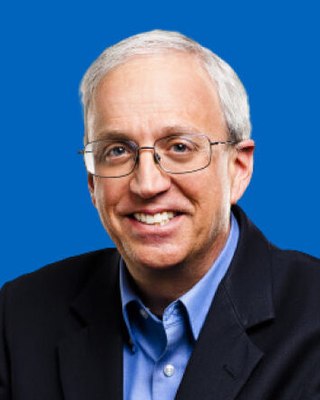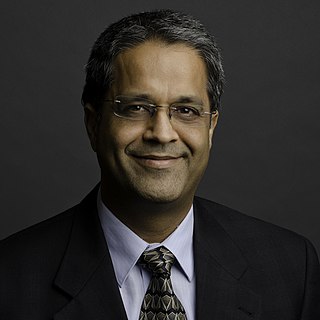
A supercomputer is a type of computer with a high level of performance as compared to a general-purpose computer. The performance of a supercomputer is commonly measured in floating-point operations per second (FLOPS) instead of million instructions per second (MIPS). Since 2017, supercomputers have existed which can perform over 1017 FLOPS (a hundred quadrillion FLOPS, 100 petaFLOPS or 100 PFLOPS). For comparison, a desktop computer has performance in the range of hundreds of gigaFLOPS (1011) to tens of teraFLOPS (1013). Since November 2017, all of the world's fastest 500 supercomputers run on Linux-based operating systems. Additional research is being conducted in the United States, the European Union, Taiwan, Japan, and China to build faster, more powerful and technologically superior exascale supercomputers.
Floating point operations per second is a measure of computer performance in computing, useful in fields of scientific computations that require floating-point calculations.

Chester Gordon Bell is an American electrical engineer and manager. An early employee of Digital Equipment Corporation (DEC) 1960–1966, Bell designed several of their PDP machines and later became Vice President of Engineering 1972–1983, overseeing the development of the VAX computer systems. Bell's later career includes entrepreneur, investor, founding Assistant Director of NSF's Computing and Information Science and Engineering Directorate 1986–1987, and researcher emeritus at Microsoft Research, 1995–2015.

Jack Joseph Dongarra is an American computer scientist and mathematician. He is the American University Distinguished Professor of Computer Science in the Electrical Engineering and Computer Science Department at the University of Tennessee. He holds the position of a Distinguished Research Staff member in the Computer Science and Mathematics Division at Oak Ridge National Laboratory, Turing Fellowship in the School of Mathematics at the University of Manchester, and is an adjunct professor and teacher in the Computer Science Department at Rice University. He served as a faculty fellow at the Texas A&M University Institute for Advanced Study (2014–2018). Dongarra is the founding director of the Innovative Computing Laboratory at the University of Tennessee. He was the recipient of the Turing Award in 2021.

ASCI Red was the first computer built under the Accelerated Strategic Computing Initiative (ASCI), the supercomputing initiative of the United States government created to help the maintenance of the United States nuclear arsenal after the 1992 moratorium on nuclear testing.
Gravity Pipe is a project which uses hardware acceleration to perform gravitational computations. Integrated with Beowulf-style commodity computers, the GRAPE system calculates the force of gravity that a given mass, such as a star, exerts on others. The project resides at Tokyo University.

William James Dally is an American computer scientist and educator. He is the chief scientist and senior vice president at Nvidia and was previously a professor of Electrical Engineering and Computer Science at Stanford University and MIT. Since 2021, he has been a member of the President's Council of Advisors on Science and Technology (PCAST).
David E. Keyes is a Senior Associate to the President of King Abdullah University of Science and Technology (KAUST) and the Director of the Extreme Computing Center at King Abdullah University of Science and Technology (KAUST). He was the inaugural Dean of the Division of Computer, Electrical, and Mathematical Sciences and Engineering (CEMSE) at KAUST and remains an adjunct professor in Applied Physics and Applied Mathematics at Columbia University and an affiliate of several laboratories of the U.S. Department of Energy. With backgrounds in engineering, applied mathematics, and computer science, he works at the algorithmic interface between parallel computing and the numerical analysis of partial differential equations, across a spectrum of aerodynamic, geophysical, and chemically reacting flows.
In computing, performance per watt is a measure of the energy efficiency of a particular computer architecture or computer hardware. Literally, it measures the rate of computation that can be delivered by a computer for every watt of power consumed. This rate is typically measured by performance on the LINPACK benchmark when trying to compare between computing systems: an example using this is the Green500 list of supercomputers. Performance per watt has been suggested to be a more sustainable measure of computing than Moore's Law.
The FETI-DP method is a domain decomposition method that enforces equality of the solution at subdomain interfaces by Lagrange multipliers except at subdomain corners, which remain primal variables. The first mathematical analysis of the method was provided by Mandel and Tezaur. The method was further improved by enforcing the equality of averages across the edges or faces on subdomain interfaces which is important for parallel scalability for 3D problems. FETI-DP is a simplification and a better performing version of FETI. The eigenvalues of FETI-DP are same as those of BDDC, except for the eigenvalue equal to one, and so the performance of FETI-DP and BDDC is essentially same.

John Leroy Gustafson is an American computer scientist and businessman, chiefly known for his work in high-performance computing (HPC) such as the invention of Gustafson's law, introducing the first commercial computer cluster, measuring with QUIPS, leading the reconstruction of the Atanasoff–Berry computer, inventing the unum number format and computation system, and several awards for computer speedup. Currently he is the Chief Technology Officer at Ceranovo, Inc. He was the Chief Graphics Product Architect and Senior Fellow at AMD from September 2012 until June 2013, and he previously held the positions of Architect of Intel Labs-SC, CEO of Massively Parallel Technologies, Inc. and CTO at ClearSpeed Technology. Gustafson holds applied mathematics degrees from the California Institute of Technology and Iowa State University.

The New Yam Festival of the Igbo people is an annual cultural festival by the Igbo people that is held at the end of the rainy season in early August.
Chike Obi was a Nigerian politician, mathematician and professor.
The Seymour Cray Computer Engineering Award, also known as the Seymour Cray Award, is an award given by the IEEE Computer Society, to recognize significant and innovative contributions in the field of high-performance computing. The award honors scientists who exhibit the creativity demonstrated by Seymour Cray, founder of Cray Research, Inc., and an early pioneer of supercomputing. Cray was an American electrical engineer and supercomputer architect who designed a series of computers that were the fastest in the world for decades, and founded Cray Research which built many of these machines. Called "the father of supercomputing," Cray has been credited with creating the supercomputer industry. He played a key role in the invention and design of the UNIVAC 1103, a landmark high-speed computer and the first computer available for commercial use.

James Weldon Demmel Jr. is an American mathematician and computer scientist, the Dr. Richard Carl Dehmel Distinguished Professor of Mathematics and Computer Science at the University of California, Berkeley.

Japan operates a number of centers for supercomputing which hold world records in speed, with the K computer being the world's fastest from June 2011 to June 2012, and Fugaku holding the lead from June 2020 until June 2022.

Alan Stuart Edelman is an American mathematician and computer scientist. He is a professor of applied mathematics at the Massachusetts Institute of Technology (MIT) and a Principal Investigator at the MIT Computer Science and Artificial Intelligence Laboratory (CSAIL) where he leads a group in applied computing. In 2004, he founded a business called Interactive Supercomputing which was later acquired by Microsoft. Edelman is a fellow of American Mathematical Society (AMS), Society for Industrial and Applied Mathematics (SIAM), Institute of Electrical and Electronics Engineers (IEEE), and Association for Computing Machinery (ACM), for his contributions in numerical linear algebra, computational science, parallel computing, and random matrix theory. He is one of the creators of the technical programming language Julia.

Inderjit S. Dhillon is the Gottesman Family Centennial Professor of Computer Science and Mathematics at the University of Texas at Austin, where he is also the Director of the ICES Center for Big Data Analytics. His main research interests are in machine learning, data analysis, parallel computing, network analysis, linear algebra and optimization.
Edmond Chow is a full professor in the School of Computational Science and Engineering of Georgia Institute of Technology. His main areas of research are in designing numerical methods for high-performance computing and applying these methods to solve large-scale scientific computing problems.

Horst D. Simon is a computer scientist known for his contributions to high-performance computing (HPC) and computational science. He is director of ADIA Lab in Abu Dhabi, UAE and editor of TOP500.












